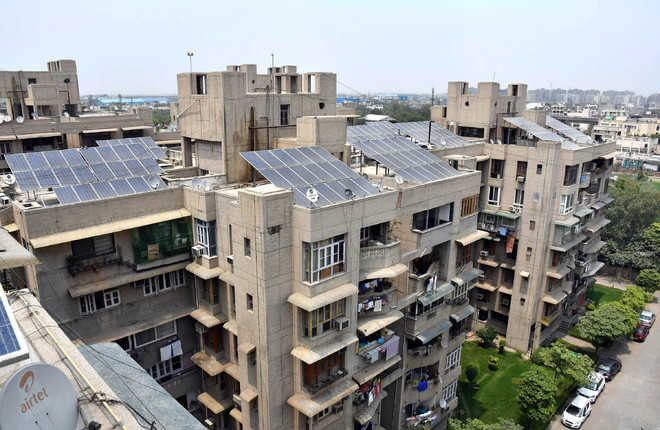
Sunrise: Rooftop solar power plant at IP Extension's Milan Vihar apartments
Swati Dey
Those living in the Capital hate the sun during summer, but not residents of Milan Vihar Apartments, IP Extension. It all changed ever since they switched over to solar energy. The housing society was the first to get a 141 kWp (kilowattpeak) rooftop solar power plant. It lapped up the Delhi Government’s proposal that offered 30 per cent subsidy on solar plant installation from select authorised contractors.
Rakesh Sharma, the RWA secretary of society, says they are expecting the bills to be halved now, with a subsidy of Rs 4.66 on each unit and an additional bonus of Rs 2 per unit.
To reduce the bills further, the society plans to upgrade the plant to 300 kWp, expecting an annual saving of about Rs 18 lakh without spending a single penny.
Inspired from them, Dwarka residents too are going in for solar power. BSES Rajdhani, in collaboration with TERI and a German company, installed rooftop solar plants of a capacity of 506kW at seven societies under the ‘Solar City Initiative — Solarise Dwarka’ programme. The plant is said to be benefitting more than 700 flats saving around 6.5 lakh units of power and Rs 32 lakh annually.
Towards the North
Up north in Ladakh, Global Himalayan Expedition (GHE) brought solar power to hamlets that are off the radar of surveys. Paras Loomba, an electronics engineer, envisaged the project. He and his team that includes engineers Jaideep Bansal (30), an IIT Bombay graduate who left P&G, and Gaganpreet Singh (32), an NIT Jalandhar graduate who switched from Microsoft, look for villages far away from government’s layout to install an electric grid.
The team coordinates with the authorities to seek permission and with the locals who can convince villagers to invest in the plan. “Forget electricity, some of these villages do not even have roads,” says Loomba. When GHE electrified Shade, a hamlet, it took them seven days to take the equipment over mules and donkeys from the nearest motorable road.
The team provides self-manufactured basic electronics goods as well as recreational items like solar-powered televi sions. “All the electronics are designed and manufactured by us to sustain quality. A warranty of two years is also promised. One person from our team visits the villages and checks the equipment from time to time.”
They also train the locals in assembling and repairing the solar micro-grid products. “At Leh, the service centre is managed by three women,” shares Loomba. On July 23, GHE electrified Thangso village in Zanskar, their 65th. According to GHE, there are 22 more villages awaiting electrification in Ladakh alone. Up next for its team would be Ralakung in Ladakh, where the voting booth has to be flown through choppers during elections!
Eastwards
There are those who feel darkness after sundown is their destiny. Palkot village was one of them till recently. Mandeep, a resident of Palamu in Jharkhand, has been working in the village for about a year now. Under the Jharkhand State Livelihood Promotion Society, he looks after the promotion of solar lamps among different communities in the nearby villages, including those in hilly terrains like Bartoli, which is deprived of, not just electricity, but drinking water too.
In July 2017, a team from IIT-Bombay visited and assessed the tribal hamlet, along with the JSLPS team, to provide solar products under the Solar Urja Lamp (SoUL) project, says Aritra Chakrabarty, assistant project manager (research). The project provided solar lamps worth Rs 600 at a subsidised cost of Rs 100 with a one-year warranty to about 20 households. The community now feels motivated to educate its younger generation. Most households have purchased lamps to ensure that children can study at night too. The little change is a big one for them.
In 2015, Baripatha, a tribal village in Odisha with about 61 households and 350 persons, got solar panels installed under a CSR project of Ecco Solar with NALCO.
While it isn’t hard to imagine remote villages deprived of electricity, it was ironic that a village like Dharnai that is situated near the Patna-Gaya national highway, and even boasts of a railway halt goes dark at night.
The villagers relied on diesel generators for agricultural purposes until it was solarised in 2014 following the collaborative efforts of NGOs like Greenpeace India, BASIX and CEED. The solar grid, which has been installed illuminated two schools, a health centre, a farmer training centre, an anganwadi, about 450 houses comprising 2,400 residents, other than the commercial shops, water pumps and street lights.
The irony was negated.



























